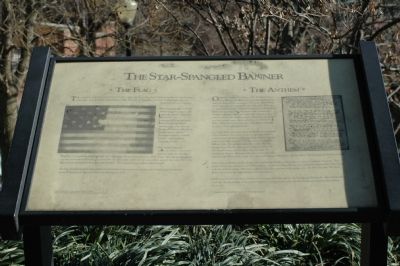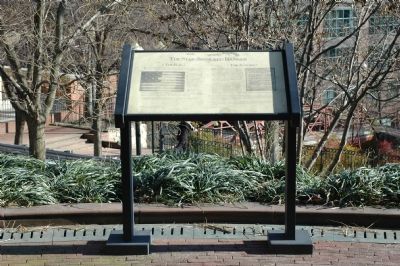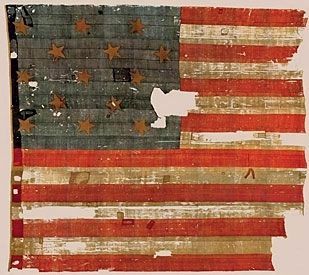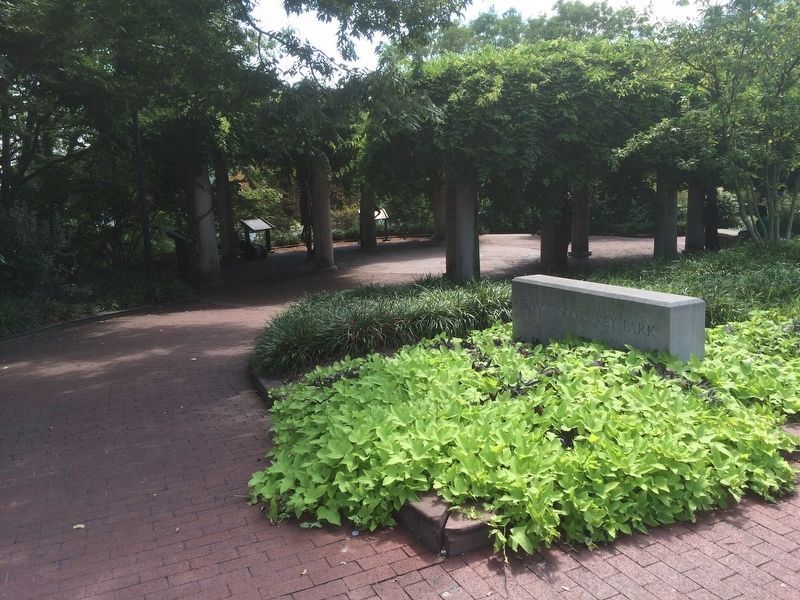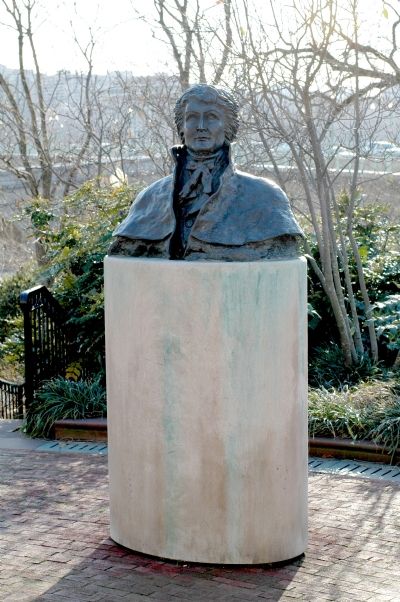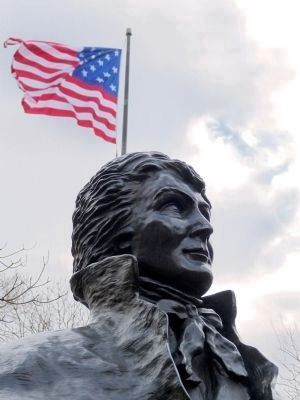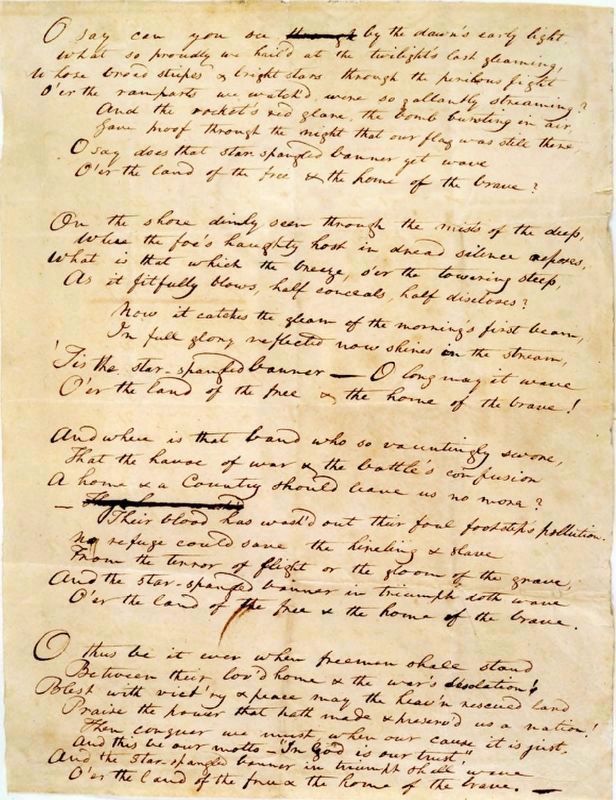Georgetown in Northwest Washington in Washington, District of Columbia — The American Northeast (Mid-Atlantic)
The Star-Spangled Banner
The Flag. The immortal words "star-spangled Banner" refer to the magnificent flag which Francis Scott Key saw "by the dawn's early light" after the British bombardment of Fort McHenry on September 14, 1814. It is the largest flag ever flown in battle in U.S. history.
During preparations to defend Baltimore's vital seaport and center of commerce during the War of 1812, the commander of Fort McHenry, Major George Armistead, wanted a flag so big "that the British will have no difficulty in seeing it from a distance." Armistead wanted a "suitable ensign," a clear signal of American resolve.
Mary Young Pickersgill, a "maker of colours," was commissioned to make the new flag. With her 13-year-old daughter Caroline, the work began. Each stripe, eight red and seven white, was two feet wide. Every star, fifteen in all, spanned spanned two feet from point to point. The completed flag weighed eighty pounds!
The Star-Spangled Banner, immortalized by Francis Scott Key, is now on display at the Smithsonian Institution's National Museum of American History in Washington, D.C.
The Anthem. Originally entitled The Defence of Ft. McHenry, Francis Scott Key's poem effectively dramatized the bombardment, the flag, and the sentiment of the times. Key's stirring verses were soon set to a popular tune of the day. The song, To Anacreon in Heaven,* has been attributed to John Stafford Smith and was sung by the members of the Anacreontic Society, an English music and social club. However, the melody had become familiar to many Americans who knew it as the patriotic song, Adams and Liberty, by Robert Treat Paine. When Key's lyrics were set to this music, it became known as The Star-Spangled Banner.
In George Town, nine years before the British bombardment of Fort McHenry, Francis Scott Key composed a poem to commemorate the victory of Commodore Stephen Decatur and his brave men over the Tripolitan pirates during the Barbary Wars. The poem contains the words, "the star-spangled flag," has the same metric composition, has the same length verses, and was set to the same tune: To Anacreon in Heaven. Moreover, the stanzas have the same repetitive last lines in both songs. So it was at his George Town home that the idea of The Star-Spangled Banner was born.
The American people quickly adopted The Star-Spangled Banner as the song to be sung on patriotic occasions. The greatest boost came during the Civil War when it was sung by Union troops. Later the Army required that it be played each day at flag lowering. The Navy ordered it played at morning and evening colors. In 1916 President Woodrow Wilson declared it the Armed Forces' official anthem.
On March 3rd, 1931 President Herbert Hoover signed the law making The Star-Spangled Banner the official National Anthem. As the anthem of the United States of America, these words and the melody are renowned throughout the world.
*Anacreon was a lyric poet of Ancient Greece.
Topics and series. This historical marker is listed in these topic lists: Arts, Letters, Music • Forts and Castles • War of 1812. In addition, it is included in the Former U.S. Presidents: #28 Woodrow Wilson, and the Former U.S. Presidents: #31 Herbert Hoover series lists. A significant historical date for this entry is March 3, 1931.
Location. This marker has been replaced by another marker nearby. It was located near 38° 54.287′ N, 77° 4.08′ W. Marker was in Northwest Washington in Washington, District of Columbia. It was in Georgetown. Marker was at the intersection of M Street Northwest and 34th Street Northwest, on the left when traveling west on M Street Northwest. This marker is in the Francis Scott Key Park which is between M Street and the C&O Canal on the east side of the Key Bridge. Touch for map. Marker was at or near this postal address: 3350 M Street Northwest, Washington DC 20007, United States of America. Touch for directions.
Other nearby markers. At least 8 other markers are within walking distance of this location. Window on Washington (here, next to this marker); Francis Scott Key Park … a place to reflect
(here, next to this marker); An Industrial Georgetown (within shouting distance of this marker); Forrest Marbury House (within shouting distance of this marker); Francis Scott Key Bridge (within shouting distance of this marker); Halcyon House (within shouting distance of this marker); Houses With A Prospect (about 400 feet away, measured in a direct line); a different marker also named Halcyon House (about 400 feet away). Touch for a list and map of all markers in Northwest Washington.
Also see . . . The Star-Spangled Banner. About the flag at the Smithsonian's American History Museum web site. (Submitted on February 24, 2006.)
Additional commentary.
1. The Star Spangled Banner
The original Star Spangled Banner which flew over Fort McHenry is on display at the Smithsonian Museum of American History in Washington DC.
— Submitted December 4, 2008, by Tom Fuchs of Greenbelt, Maryland.
Credits. This page was last revised on December 10, 2023. It was originally submitted on February 24, 2006, by Tom Fuchs of Greenbelt, Maryland. This page has been viewed 6,469 times since then and 24 times this year. Last updated on April 18, 2015, by Allen C. Browne of Silver Spring, Maryland. Photos: 1, 2. submitted on February 24, 2006, by Tom Fuchs of Greenbelt, Maryland. 3. submitted on September 11, 2011. 4. submitted on September 11, 2016, by J. Makali Bruton of Accra, Ghana. 5. submitted on February 23, 2006, by Tom Fuchs of Greenbelt, Maryland. 6. submitted on April 18, 2015, by Allen C. Browne of Silver Spring, Maryland. 7. submitted on August 21, 2016, by Allen C. Browne of Silver Spring, Maryland. • Bill Pfingsten was the editor who published this page.
